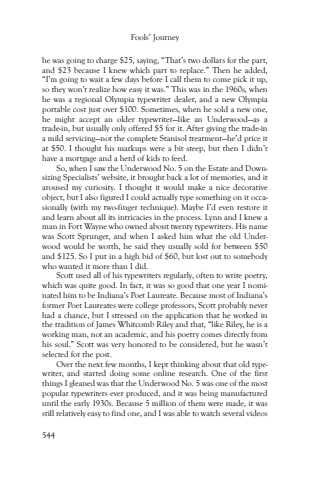Page 550 - Demo
P. 550
Fools%u2019 Journey544%u2022%u2022%u2022%u2022%u2022There was a business in Bloomington called Estate and Downsizing Specialists. As its name implied, when someone wanted to sell off some of their belongings so they could move into a smaller residence, or a family needed to dispose of an entire estate, the company would catalog and photograph those possessions and list them for sale through their on-line auction. Lynn and I perused their website occasionally, but not with any regularity. Over several years, we had bid on, and won, two small, ethnic statues. One day I spotted an old upright, black, Underwood No. 5 typewriter on their auction. It dated from the 1920s, looked like a dinosaur, and was the type of machine my dad had repaired and sold when I was a young boy. Back then, I asked him, on more than one occasion, to teach me how to repair them, and each time he just said, %u201cNo, you don%u2019t want learn to do that.%u201d I%u2019d asked because I did want to learn. The mechanical nature of typewriters intrigued me, and I wanted to know more about how they operated. Of course, he did teach me other things. Such as how to change a ribbon when a customer brought in a typewriter for a new one, how to count out change at the checkout counter, and how to look at an invoice, which listed the wholesale cost per dozen, and calculate the retail selling price per unit. But actually fixing typewriters would have been much more fun. If he had just given me an old one that was worn-out just to play with and dismantle, I would have enjoyed it immensely. But he never did, and I never thought to ask for one.Dad started selling typewriters in 1938, six years after graduating from high school. He was able to obtain an exclusive franchise to sell Remington Rand models for the area surrounding Fowler %u2014 including part of Illinois. The company also put him through a training course for a week in Chicago to learn to repair them, so he was able to refurbish and sell used machines too. But when he was drafted into the Army Air Corps in 1942, he had to place all his business records, equipment, and inventory in storage. While in the military, he worked as a typewriter mechanic for a year, then learned to do typographic work decoding messages. When he returned to Fowler after the war, he was pleased to find a pent-up


